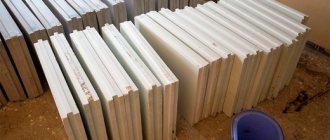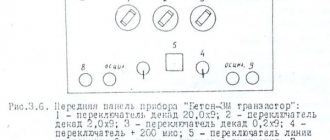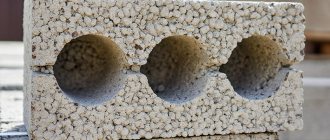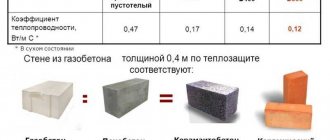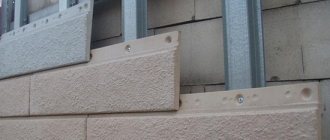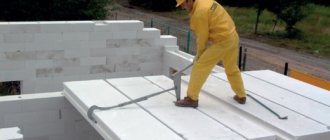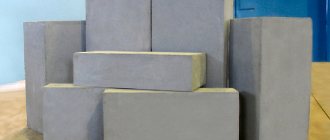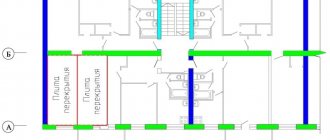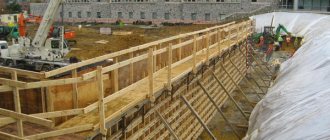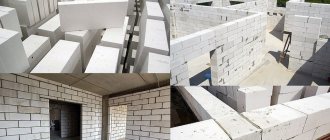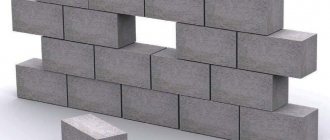We continue our traditional series of articles from Yuri Voedilo (professional builder and repairman). Yuri writes:
Recently, heating prices have been growing enormously, so many people pay great attention to external wall insulation. Therefore, I decided to pay attention to this topic. This article will discuss the insulation of the external walls of a brick house with facing bricks. Next we will talk about the tricks of laying the brick itself and the need for bulk insulation. Also, in the article we will give examples of laying out an arch.
The ventilated air space allows the interior of the brick wall to dry, but exterior vents can introduce small amounts of moisture—rainwater or humidity—into the assembly in a natural stacking effect. Clean drying of the wall assembly can reduce the likelihood that the bricks will reach critical levels of moisture content that will initiate freeze-thaw damage.
The effectiveness of one or both approaches could be established; test results can indicate which approach is best based on the direction and environmental exposure of each wall.
Heritage preserved, future secured The existing stock of stone buildings is ripe for future use. However, if Canadian heritage buildings are to be adapted, reused and extended, their thermal performance must be improved to meet tenant comfort needs and owner energy performance expectations.
The house, lined with ceramic bricks, has a very pleasant and neat appearance. But only under the condition that the brick is laid correctly, that is, the seams should be smooth and clean, and the brick itself should not be stained with mortar or have cracks.
Stage 1. Mortar for laying facing bricks
To work we will need the following tools:
One step to reduce energy consumption in older masonry buildings is to insulate their exterior walls by applying interior insulation. With careful evaluation and testing, designers can detail an insulation retrofit strategy to reduce energy loss without compromising durability.
Notes 1 The authors would like to thank those who have contributed to research and design work on this topic. These include Ekaterina Tsekova and Marianne Cutty, Paul Pasqualini from Engineering Link and Dr. John Straube, Chris Schumacher and Randy Van Stratten from the University of Waterloo and the Building Science Corporation.
- Construction trowel;
- Building level;
- Thread or fishing line
- Rod 8-12 mm (square reinforcement);
- Grinder with a circle on concrete;
- Cement, sand;
- Polystyrene foam in bulk form.
First, let's prepare a solution. Everything is according to the standard scheme: one part 400 grade cement and three parts sand, preferably not river sand, since the solution on river sand will set very quickly. But if you don’t have any other sand, then add a plasticizer to the solution; you can buy it at any hardware store. The density of the mortar should be such that it can be easily scooped up with a trowel and applied to the brick. More and more often, various types of pigments (special dyes) are added to the mortar on which brick laying will be carried out. Therefore, a little advice: before buying a brick, consider combining the color of the brick with the color of the seam itself. In our case, the client wanted a classic seam color, that is, gray.
He specializes in performance analysis, durability assessment and cladding design for new construction and building renovations. She specializes in building rehabilitation for heritage buildings, developing solutions that balance cultural considerations with the needs of modern occupants. His research interests include the design and construction of low energy buildings. Cinder blocks are used in construction because of their ease of installation, durability, and low cost.
However, the appearance that the blocks provide is very simple and utilitarian. One fairly simple way to hide cinder blocks is to fake paint them to look like a brick wall. Brick walls have a slightly warmer appearance than cinder block walls.
Methods for cladding houses made of aerated concrete with bricks
The structure of aerated blocks is faced in several ways.
Dense masonry without technical gaps
This technology involves the construction of a brick wall close to aerated concrete. At the same time, the thickness of the block masonry is 20-40 cm, the facing one is 12 cm (half a brick). The method is entirely suitable for the construction of unheated premises. If you plan to build a heated house, then dense facing masonry is not suitable.
Due to the lack of a technical gap between the walls, aerated concrete will quickly begin to collapse. This is facilitated by unevenly accumulating condensate formed in block layers after the meeting of two air flows with different temperatures. Due to the low resistance of aerated concrete to moisture, the material is rapidly destroyed.
Brick laying maintaining a gap from the aerated concrete wall (without ventilation)
This cladding method is also more suitable for unheated premises, but in some cases it can be used in the construction of heated houses, subject to the basic rules. First of all, this is the interval between the walls, the indicator should correspond to 4 cm. The facing masonry is done in half a brick or in one brick. The layers are separated by blind diaphragms made of non-flammable material, divided into zones of 3 m.
The disadvantage of this method for heated housing is the possible accumulation of condensation near the foundation surface. High-quality waterproofing will help to avoid premature destruction of aerated concrete and the foundation.
Brick laying in compliance with the ventilation gap
This method is ideal for heated rooms. In this case, the interval between the walls is 6 cm, and holes are provided between the foundation and the cladding to ensure condensate drainage. In some cases, the air space increases to 10-15 cm. The base of the structure must have reliable protection from moisture in the form of a layer of roofing material or bitumen mastic. When laying bricks (the wall thickness is one brick), perforated partitions are installed to cut off air. The number of holes for condensate drainage is calculated according to the standard: 75 cm2 is required for 20 m2. Diversions are made with a slope towards the street.
This method is also suitable for unheated rooms, but provided that a ventilation system is installed to remove vapors to the outside.
Important! If an aerated concrete wall is insulated up to the air gap, then the side of the insulator in contact with air must have an air-protective shell. The density of insulation materials is selected with indicators of at least 90 kg/m3. Recommended options: Izospan A, AS, Megaizol SD, fiberglass, basalt wool. You should not give preference to mineral wool, polystyrene foam and glass wool.
Stage 2. Laying ceramic (cladding) bricks
There is a lot of information on the Internet about how to lay bricks, so I don’t think it’s worth writing about the basic principles. But there is not so much about the features of laying ceramic bricks, because... High-quality insulation of a house with brick requires special attention.
Wash the walls and let them dry for about 24 hours. Start by cutting around the edges of the wall, brushing on the primer. When applying primer, use smooth, even strokes. Cover the main part of the walls with paint. Cover the area, which measures about 3 feet square, before moving on to the next section. This usually takes 4 to 6 hours, but of course read the instructions on the can.
Paint the wall the color you are using to represent the faux brick mortar. This is the color that will appear in the spaces between the faux bricks. Use the same technique you used to apply the primer. Build a stamp to apply a brick pattern to a wall. Start by cutting the synthetic sponges to the size of the bricks. Glue the sponges to the plywood.
Work will begin by laying out the corners. Facing brick masonry should only be laid on waterproofing. To do this, use roofing material or thick polyethylene film. In our case, the waterproofing was built into the foundation itself, so we started laying the masonry directly on the foundation. Having retreated 4-5 centimeters from the main wall, we will carry out the masonry. We retreat these 4-5 cm for an air gap, I will explain why later. You need to lay ceramics in the same way as ordinary bricks, but only under a metal rod with a cross-section of 8 by 8 or 10 by 10, 12 by 12 millimeters.
Apply the paint you want to use on the bricks to the stamp using a roller. Start in the top corner and press the stamp firmly against the wall. Cover the entire wall using this technique and let the paint dry. Use a laser level to provide a guide when stamping the brick design onto the wall. This is a tool you can purchase or rent that projects a laser beam along the length of the wall to create a straight line.
Fill in the gaps left unpainted by the stamp by cutting the sponge to fit the spaces on the walls. Apply paint to the end of the sponge and press the sponge onto the wall in the areas that remain unprinted. For a person in a 70 year no warming block, in a place with old, leaky windows, indeed every new tight window is energy efficient. The window must be tailored to the specific requirements of the customer. This should be the answer to the question of what we should expect from windows, what tasks they should perform.
And this is how it is done: a metal rod is placed directly on the masonry itself along the front edge of the brick, and a solution is applied near it. In such a way that the thickness of the applied solution near the twig itself is no higher than the twig itself. And on the back side the solution was ten millimeters higher. This effect can be easily achieved if you use a construction trowel to cut the mortar along the twig and hold the trowel at an angle.
Energy saving with modern windows
Simply because windows are adapted to our needs, it is worth buying an offer from a company whose experienced consultants know how to choose the optimal solution for us.
During the heating season, everyone is looking for heat savings. The corresponding values can be calculated by architects when designing a house, which should generally achieve the goal of an energy-efficient house. In other cases, the best heating cost savings are after the heating season compared to last year if the windows were not replaced. It should be noted, however, that the improved parameters and quality of windows, the greater the likelihood of lower heating costs. The vertical seam is applied in the same way, only the rod is placed vertically to the end side of the brick (poke). The twig itself will not stand, so you will have to hold it while applying the solution.
Remember, however, that expensive and energy-efficient windows must also be treated properly. It is important to regularly check that window fittings are functioning correctly. Report this and ask for adjustments and best of all service from the company that built the window. Proper adjustment and maintenance of windows will prolong the comfort of their use. It is also important to install the correct windows. Note their sedimentation and isolation. If you choose "energy efficient" windows, it's worth considering "hot installation" instead of standard installation.
Note: after about 2-3 hours of work, you need to rub the seams with a small brush. At the same time, if there are holes or tears in the seams, be sure to seal them! Otherwise, when the temperature changes +/- degrees, water will get in there and when it freezes, it will tear the seam, and after a while, the brick itself. All drops of solution from the wall must also be wiped off with a rag, as after drying it will be much more difficult to wipe off. By the way, after some time, white spots may appear on the wall. This is the salt that was in the sand. There is nothing scary here; it can be easily wiped off with a rag, or you need to wait until the rain washes it off.
It is based on the fact that the window used is additionally insulated with special strips: vapor-tight and vapor-permeable. Kaisergrub Queen Shihuang in Lintong, China The concept of saving the plateau. The original stone scales consist of approximately 600 limestone tiles and are connected to each other by cast bronze wire. The goal was to salvage the tank for research and exhibition purposes. Our concept was implemented on two models. In our workshop the development and first execution took place on a small model, the second sample took place on a replica of the tank in Munich.
Laying facing bricks is a painstaking process that requires care. Therefore, be patient.
Stage 3. Making a frame for a brick arch
In order to lay an arch out of brick, we first need to make a frame for it. We don't need beauty here. The main thing is strength and even bending. Take a USB sheet 10 mm thick and use a jigsaw to cut out two half-moon strips at least 6 centimeters wide. The length and curve of the crescents are individual for each window.
The concept consists of two main elements. Firstly, the ability to carry out large-scale rescue operations in one piece, and secondly, the ability to very quickly reset all connections necessary for rescue. Job retention can continue unimpeded.
The measure was very successful, even the sensitive bronze wires were not damaged. A detailed report will be published shortly by Sandra Bucher. Reversible lamination with controlled sublimation. Cyclododecane lamination has proven to be very effective in areas where fully reversible protection is required within a short time. However, the durability of the reversible protective coating over a longer period of time was a challenge. This is problematic for larger objects, especially in the wall and architectural areas.
Next, these crescents need to be twisted together, as shown in the photo below. For this we use old bars, their thickness can be different, but the width is the same from 10 to 12 centimeters. And the length is equal to the height of our windows.
To maintain the large paint job on approximately 100 m², a reversible lamination was necessary, which stabilizes the plaster throughout the installation work on the wood plasterboard and protects the paint layer from contamination. Backup takes about 6 months.
The painting is made of lime mortar on a lime mortar. The tenons are separated by tenons that are mounted on a wooden, forked structure. This wooden substructure is directly connected to the roof of the building. Damage to the roof and worm infestation of the steel had weakened the supporting structure so much that work on the roof and right on the back of the painting became necessary. The painting must be protected by the cyclododec lining on the front side during this construction and supported by the jogging structure.
We insert the bars between the two crescents and twist them with screws 45 mm long, after which the frame is ready for use.
Stage 4. Making an arch
Having installed the frame in the place where the arched window will be, we begin to cover the frame with brick on top.
It was predicted that repair work on the roof structure and image carrier would take at least 6 months. The cover should be easy to remove and without heavy mechanical stress. Lowers wall paintings. Despite the material properties that were not provided for this purpose, we nevertheless decided that at this time the only known material that reliably adheres to cyclododecane without dissolving it and that does not harden by evaporation of solvents.
Lamination design A dense layer of cyclododecane melt is applied directly to the paint layer. 10% boiling limit gasoline was added to this layer. This bottommost layer serves as a separation layer. Boiling point gasoline was added to facilitate processing of the cyclododecane melt. A layer of cyclododecane with non-woven reinforcement was then applied. The non-woven fabric is a thin polypropylene non-woven fabric. A melt of cyclododecane was also used in this layer. It was added at a boiling point of 30%.
Only now we will lay the brick not horizontally, but vertically with the butt side on the face of the masonry. But since the length of the brick is 25 cm, and the width of our masonry is 17 cm (brick width 12.5 cm + air gap 4-5 cm), the brick will have to be cut to length. To cut bricks we will use a grinder with a diamond wheel for concrete.
The relatively high proportion of gasoline means that the cyclododecane layer is thin and the fleece adheres only moderately to the substrate. This is necessary because the last layer must be removed along with the adhesive aluminum foil after the measurement is completed. Before the next step, a waiting time of 10 hours had to be maintained to allow the boiling point gasoline to evaporate from the cyclododecane.
Aluminum foil should be glued together as a top layer. The foam was applied thinly to the prepared pieces of aluminum foil using a spatula, after which the pieces of film were pressed with a roller for lamination. After completion of construction work, the top two layers of laminate can be separated.
The adjacent bricks of the main wall will also need to be cut at an angle. The arch should be flat in relation to the main wall at the same level or protrude outward by 2-4 cm, this is a matter of client taste. After a day, three arch frames can be safely disassembled. The arch is ready.
Stage 5. Insulating the brick walls of the house with polystyrene foam from the outside
Difficulties with measure. The measure was successful overall, and the cyclododecane remained in the painting throughout the measurement and completely sublimated after the layer was cleaned with foam and alufamy. However, implementation is not without problems. On the one hand, the foam reacts very quickly, so it can only be processed for a few minutes. Processing time can be increased by cooling the foam. We used ice water. On the other hand, it is necessary to spread the foam very thinly and evenly on the aluminum foil, as parts with a thicker layer of foam become very rigid and can cause the paint layer to lose when the lamination is removed.
We will still fill the air gap that we left between the main wall and the ceramic brick. This is an integral part of lining a house with facing bricks and insulation. The next question is: what kind of insulation should be between the brick wall and the facing brick? To do this, we decided to use loose foam, which is sold in bags. Why this and not sheet foam?
Here's why. The first advantage: if for some reason the walls of the building were not level, then the loose foam plastic will not react in any way when backfilled. But with leafy ones you will have to suffer. The second advantage: mice can get into sheet foam and create a lot of passages and holes for themselves. It is impossible to make a move in loose foam because mice cannot climb on it. As they rake with their paws, they sharpen like a truck in the mud, remaining in place.
Before pouring foam into the wall, you need to close the cracks around the perimeter of windows and doors using mineral wool or sheet foam. Moreover, the latter is better, since when filling slopes it will be easier to apply putty on the foam.
Note: in order to safely insulate the walls of a brick house from the outside in windy weather, I do not recommend pouring polystyrene foam. All the foam will scatter all over your yard in the best case, and in the worst case it will even sweep away your neighbors.
Building the walls of a house from aerated concrete - is it necessary to line it with brick?
Nowadays, the construction of a house made of aerated concrete with brick cladding is in considerable demand.
After all, a building erected from aerated blocks and then lined with brickwork will cost much less than building a cottage entirely from brick.
At the same time, houses made of aerated concrete blocks lined with brick look more modern and aesthetically pleasing, and the financial investment is significantly less.
However, Metroplex experts decided to help figure out whether it really is an attractive appearance when building houses from aerated concrete with brick cladding.
Pros and cons of building a house with aerated concrete with brick cladding
So, building a house from aerated concrete with its subsequent cladding has a number of advantages, among which it is worth highlighting:
- sound insulation;
- visual aesthetics;
- the ability to strengthen the building;
- significantly shorter construction time for a house made of aerated concrete and its cladding;
- increase in service life.
However, like any option, aerated concrete walls lined with finishing bricks have their drawbacks: 1.
Violation of masonry technology entails the accumulation of condensate in the wall cavity and, accordingly, subsequently negatively affects the structure itself.
That is why the construction of a house made of aerated concrete should be carried out exclusively by qualified builders. 2.
Additional costs for construction and materials, which significantly increases the price of building a turnkey aerated concrete house .
It is worth noting here that in any case, a significant expense item is assigned to the cladding of the building, since the construction of houses from aerated concrete is really inexpensive , and the structure itself is very stable. There are tests carried out regarding the strength and durability of a wall made of aerated concrete blocks with brick cladding, as a result of which it was found that the service life of such a structure can vary between 60-110 years. A single climate zone and materials of the same quality were taken into account. In a word, houses made of aerated concrete blocks can have operational lives that differ from each other by almost half. What's the matter? And it all depends on when the construction of the aerated concrete house began , and whether there is a gap and ventilation between the main wall and the brick cladding.
Types of cladding of aerated concrete walls
An aerated concrete wall can be faced with brick using several methods.
Here we are talking about the distance between aerated concrete blocks, the presence of insulation and the gap between the wall of the building and the facing material.
In this case, the price to build a house in Kharkov may differ significantly. Let's look at the existing options:
DENSE BRICK LAYING WITHOUT VENTILATION AND GAPS
This option is usually used when inexpensive construction of aerated concrete houses is planned. Yes, it has a right to exist, but for a heated building this method is very disastrous.
The temperature difference between the structure outside and inside will significantly reduce its service life. Condensation accumulates between the aerated concrete wall and the brickwork, destroying both materials at the same time.
It is worth noting that condensate accumulates unevenly and leads to rapid destruction of aerated concrete blocks.
BRICK COVERING AT A DISTANCE, BUT WITHOUT VENTILATION
In accordance with existing building codes, the closer the facing material is to the surface, the lower the level of vapor permeability should be.
According to the same norms and rules, the thickness of the non-ventilated distance should not be less than 4 cm.
In this case, the layers must be divided among themselves into small zones of 3 meters using blind diaphragms made of non-combustible material.
FINISHING AERATED CONCRETE WALLS WITH VENTILATION
This option is most ideal when building a house from aerated concrete for permanent residence. It is this type that allows you to significantly increase the service life of the structure.
It is important that the thickness of the air space is at least 6 cm and does not exceed 15 cm. In this case, the aerated concrete wall itself acts as a thermal insulation material.
order such construction of houses in the city of Kiev today from Metroplex experts.
ALSO USEFUL
Stage 6. Final work
Advice: few builders know this secret: when all the work on insulating a house with bricks is completed, spare no expense and buy a couple of canisters of liquid silicone at a construction supermarket. And carefully paint all the brickwork, especially the seams, they can even be filled in. After drying, a barely noticeable transparent film will remain on the wall. Thanks to it, your home will look like new for 5-10 years longer. If you don’t have enough money for liquid silicone, then replace it with a deep penetration primer, just remember that there are no drips on the brick, otherwise after drying you will be in for a very unpleasant surprise. And so, all work on laying facing bricks and insulating the brick house is completed. Although this type of insulation is a little expensive, it will serve you for many years.
A good owner knows that without high-quality insulation, keeping the house warm will be problematic. Moreover, today the issue of energy saving is more than acute.
And it doesn’t matter whether you are going to build a house or you already have a finished structure - it needs to be properly insulated.
What to do to avoid heating the air around the house? The answer is simple - figure out what and how you can insulate the brick walls of your home.
Brick house - pros and cons
Advantages of a brick house
Brick is the most common material used in low-rise construction.
The advantages of using it are as follows:
- no need for external finishing;
- there is no need for periodic renovation of the façade;
- environmental cleanliness. This building material is made from natural ingredients;
- high strength. External influences over a long period of time will not be able to harm the brickwork. True, provided that it is carried out in compliance with all standards;
- no efflorescence. Subject to compliance with manufacturing technology;
- absence of limiting factors when planning indoors. Dowels are driven loosely into the brick to hang a picture, cornice, etc. Electrical wiring is not difficult. It is not difficult to dismantle the wall, if necessary;
- regulation of humidity levels. The brick ensures free air circulation;
- strength;
Note. Strength is marked with the letter “M”. For example, M50 means that the material can withstand up to 50 kg. by 1 cm2 area.
- frost resistance;
Note. This indicator is marked with the letter “F”. For example, F50 means that this type of product can withstand up to 50 freeze-thaw cycles.
- Fire safety;
- resistance to the development of microorganisms.
Disadvantages of a brick house
However, such a house also has disadvantages. Among them are the following:
- hygroscopicity. Some types of brick can absorb water;
- condensation formation due to temperature changes.
Brick
Kinds
- Depending on the manufacturing method:
- silicate - is a mixture of sand, lime and various additives;
- ceramic – made from clay. Then it gets burned.
- Depending on the nature of the filling:
- full-bodied;
- hollow;
- porous.
Note. The more voids, the less the weight of the material and its ability to withstand loads. However, the higher the ability to retain heat.
- Depending on the scope of application:
- construction – for construction of structures
- facing - for finishing. In turn, it is divided into textured and profile;
- stove or fireclay - for stoves. It is based on refractory clay.
- Depending on the size. The size is regulated by GOST 530-2007 “Ceramic brick and stone”.
- standard. Size – 250x120x65 mm. Weight – 2.35 kg. Corresponds to the parameters of a human hand. Convenient to use;
- one and a half – 250x120x95. Weight – 3.5 kg.
- double – 50x120x140 mm. Weight – 4.7 kg.
- European – 0.7 standard size;
- modular brick - 1.3 standard sizes;
- incomplete - 1/2, 3/4 and 1/4 part of the standard one.
What influences the choice
The choice is influenced by:
- design load on the structure (walls and foundation);
- operating conditions of the building;
- architectural and aesthetic preferences.
Advantages and disadvantages of brick cladding
The advantages of cladding walls made of aerated concrete with bricks with an air gap: protects the surface of aerated concrete from the effects of precipitation; improves the thermal insulation of walls, since insulation materials can be placed in the resulting space; strengthens the house; has a longer service life; this type of finishing is suitable for buildings that are used throughout the year; a house lined with brick takes on an aesthetically modern look.
Disadvantages of brick cladding
if the technology for facing work is not followed, condensation will accumulate in the walls, which will lead to a deterioration of the microclimate in the room, the formation of mold and the destruction of aerated concrete masonry;
- an increase in the cost of constructing a building, since it will be necessary to purchase not only bricks, but also metal rods, cement, sand, insulation and vapor barrier.
This is a labor-intensive process that requires special knowledge and skills. External finishing is recommended to be done in one brick using the conventional masonry method. Sand-lime or hollow bricks are suitable for these purposes. The use of double sand-lime brick M 150 is also allowed.
Thermal insulation material
Kinds
Thermal insulation material or insulation is a structural element of a structure that is designed to help retain heat in a room.
Insulation of a brick wall can be done using various materials.
Depending on the type of feedstock, there are three types of thermal insulation materials:
- Organic.
They are made from organic raw materials. These include:
- polymers – polystyrene foam, polyethylene. They are based on styrene monomer;
- wood waste – chipboard, fibreboard, OSB;
- cellulose – ecowool;
- agricultural waste – straw, reeds.
It should be noted that the popularity of these insulation materials is limited by the scope of application (up to 100 o C), low water and bio-resistance, and susceptibility to decomposition.
However, they are very popular if there is a need for environmentally friendly materials.
Note. Brick walls with insulation of organic origin reduce heat losses slightly compared to inorganic ones.
- Inorganic.
- Soft (fiberglass and mineral or basalt fiber).
- Solid (cellular concrete (aerated concrete and gas silicate) and foam glass).
- Bulk (perlite, vermiculite, aerated concrete gravel).
Used for floor insulation in bulk form or for wall insulation - as insulation between brick and foam block or as part of plasters
- Inflatable (foam spraying).
- Combined – mixtures based on asbestos:
- asbestos cardboard;
- asbestos paper;
- asbestos felt;
Note. The value of the thermal conductivity coefficient of insulation is inversely related to the quality of thermal insulation. The higher it is, the worse the insulation.
What influences the choice
The choice is influenced by:
- wall masonry thickness;
- type of brick used in construction;
- scope of application;
- availability of ventilation;
- the presence of insulation from the inside, inside or outside the building;
- region of residence;
Note. Many manufacturers indicate the recommended thickness of insulation for brick walls, taking into account climatic conditions and the region of residence.
- humidity, temperature conditions and their changes;
- availability, quantity, sizes of windows and the material from which they are made;
Note. If you can put a film on wooden frames, and thus retain heat. So, insulating plastic windows is impossible. It is necessary to initially provide for the use of a high-quality profile, at least a double-glazed window, and a high-quality and dense rubber gasket. As well as high-quality work on assembling these components and installing the window unit.
Features of aerated concrete structures
Aerated concrete is produced using a special technology using blowing agents. When mixed into a solution, they produce many small air bubbles, resulting in a lightweight material with thermal insulation characteristics. The disadvantage of blocks is their low resistance to moisture, winds, and sunlight. Therefore, to create protection for the aerated concrete structure, it is necessary to install facing material from the outside.
• affordable price of blocks, unlike other materials;
• savings on the foundation part due to light weight;
• short construction time;
• there is no need to mix cement-sand mortar to connect the blocks.
However, giving preference to modern material, it is worth considering that installation work requires strict adherence to technology. This is especially true for the rules for carrying out work on forcing walls. This takes into account both the ability of aerated concrete to absorb moisture and the technique of applying an adhesive composition to the ends of the blocks. Even weather conditions play a role, so it is recommended to carry out work only in dry weather with positive temperatures.
Insulation
Kinds
When planning to insulate the brickwork of a house, you should first decide on which side the insulation will be carried out. After all, this has a direct impact on the choice of material.
There are three known ways to use thermal insulation:
- External insulation.
In this case, all insulation work will be carried out from the outside of the building.
For external work, it is advisable to use the following thermal insulation:
- mineral wool;
- polystyrene foam, polystyrene foam;
- cellular concrete.
Note. Insulation of a brick chimney is carried out only with the use of soft thermal insulation, such as glass wool or mineral wool. This makes the job easier. In addition, consider the temperature range at which a particular type of soft thermal insulation can be used.
As a rule, a wall covered with insulation requires decorative facade work. On the one hand, this will extend the service life of the insulation. On the other hand, it will give the building a more aesthetic appearance.
So-called sandwiches – brick-like façade panels with insulation – have become widespread as materials for decoration. These are multilayer structures that look like part of a finished brick wall with insulation. Their structure is shown in the photo.
Various materials are used as insulation. The price of the panels depends on the cost of the thermal insulation layer.
Sandwiches are convenient because they are easy to assemble with your own hands, even without special knowledge in the field of construction and finishing.
Another popular material for exterior decoration is vinyl siding of various colors and textures. However, brick siding with insulation is not available on the market, and therefore it needs to be installed only on an insulated wall.
Video instructions for insulating a house with your own hands are presented in other articles on our website.
- Insulation between masonry.
This method is used both in the construction of new houses and insulating existing ones.
- Internal insulation.
The most popular materials for this are polystyrene foam, polystyrene foam and cotton wool. And for non-residential buildings and warehouses - foam concrete and aerated concrete.
An example of internal insulation would be the insulation of a loggia, which, in fact, is a continuation of the living space. Here it is important to achieve an optimal balance between the thickness of thermal insulation and usable area.
Installation characteristics
- Solid thermal insulation.
Installation features:
- the plate is attached to the adhesive solution;
- then fixed with a dowel;
- covered with another layer of solution;
- covered with mesh for reinforcement or fiberglass;
- a layer of plaster is applied
- The surface is painted.
Note. If you do not plan to use plaster, then the amount of work will be reduced. First you need to “plant” the sheet with glue, then secure it with a dowel, then proceed to finishing.
The design of a brick wall with this type of insulation is shown in the photo.
Brick cladding of aerated concrete house: features and cladding methods
The construction of houses made of aerated concrete is gaining momentum due to the affordable cost of building materials. But such a design is exposed to external factors, so after the box has been driven out, cladding is done. The article will discuss one of the popular methods of finishing external walls, which involves the use of brick.
